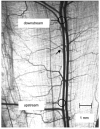Differential structural adaptation to haemodynamics along single rat cremaster arterioles
- PMID: 12611919
- PMCID: PMC2342855
- DOI: 10.1113/jphysiol.2002.035907
Differential structural adaptation to haemodynamics along single rat cremaster arterioles
Abstract
We tested the hypothesis that under physiological conditions, arterioles match their diameter to the level of shear stress. Haemodynamic and anatomical data were obtained in segments of the first-order arteriole of the rat cremaster muscle. Along this segment of ~10 mm in length, local blood pressure decreased from 68 +/- 4 mmHg upstream to 54 +/- 3 mmHg downstream (n = 5). Pulse pressure decreased from 8.2 +/- 1.3 mmHg upstream to 4.1 +/- 0.6 mmHg downstream. At the same locations, an increase in arteriolar diameter was measured in vivo, from 179 +/- 4 microm upstream to 203 +/- 4 microm downstream (n = 10). In vitro pressure-diameter relations of maximally dilated vessels showed that the passive diameter was larger in downstream than upstream segments over a 15-125 mmHg pressure range (n = 18). The wall stress was similar for the upstream vs. downstream location: 266 +/- 16 vs. 260 +/- 14 mN mm-2. However, shear stress decreased from 30 +/- 5 to 21 +/- 5 dyn cm-2 (3.0 +/- 0.5 to 2.1 +/- 0.5 N m-2; n = 4) along the artery. In conclusion, these results demonstrate that shear stress is not the only factor in determining vascular calibre. We suggest that arteriolar calibre may rather depend on an interplay between shear stress and the local pressure profile.
Figures





Similar articles
-
Adaptation of flow-induced dilation of arterioles to daily exercise.Microvasc Res. 1998 Jul;56(1):54-61. doi: 10.1006/mvre.1998.2083. Microvasc Res. 1998. PMID: 9683563
-
Connexin expression and conducted vasodilation along arteriolar endothelium in mouse skeletal muscle.J Appl Physiol (1985). 2004 Sep;97(3):1152-8. doi: 10.1152/japplphysiol.00133.2004. Epub 2004 May 28. J Appl Physiol (1985). 2004. PMID: 15169746
-
Vascular cell transcriptomic changes to exercise training differ directionally along and between skeletal muscle arteriolar trees.Microcirculation. 2017 Feb;24(2). doi: 10.1111/micc.12336. Microcirculation. 2017. PMID: 27889934 Review.
-
Biomechanical model for the myogenic response in the microcirculation: Part II--Experimental evaluation in rat cremaster muscle.J Biomech Eng. 1996 May;118(2):152-7. doi: 10.1115/1.2795953. J Biomech Eng. 1996. PMID: 8738778
-
Coupling of muscle metabolism and muscle blood flow in capillary units during contraction.Acta Physiol Scand. 2000 Apr;168(4):531-41. doi: 10.1046/j.1365-201x.2000.00706.x. Acta Physiol Scand. 2000. PMID: 10759590 Review.
Cited by
-
Structural remodeling of the mouse gracilis artery: coordinated changes in diameter and medial area maintain circumferential stress.Microcirculation. 2012 Oct;19(7):610-8. doi: 10.1111/j.1549-8719.2012.00194.x. Microcirculation. 2012. PMID: 22587333 Free PMC article.
-
Near-Wall Migration Dynamics of Erythrocytes in Vivo: Effects of Cell Deformability and Arteriolar Bifurcation.Front Physiol. 2017 Nov 29;8:963. doi: 10.3389/fphys.2017.00963. eCollection 2017. Front Physiol. 2017. PMID: 29238303 Free PMC article.
-
Conducted dilatation to ATP and K+ in rat skeletal muscle arterioles.Acta Physiol (Oxf). 2017 Jan;219(1):202-218. doi: 10.1111/apha.12656. Epub 2016 Feb 22. Acta Physiol (Oxf). 2017. PMID: 26804547 Free PMC article.
-
Effect of cell-free layer variation on arteriolar wall shear stress.Ann Biomed Eng. 2011 Jan;39(1):359-66. doi: 10.1007/s10439-010-0130-3. Epub 2010 Jul 23. Ann Biomed Eng. 2011. PMID: 20652744 Free PMC article.
-
Characteristics of the response of the iliac artery to wall shear stress in the anaesthetized pig.J Physiol. 2007 Jul 15;582(Pt 2):731-43. doi: 10.1113/jphysiol.2007.128736. Epub 2007 Apr 5. J Physiol. 2007. PMID: 17412772 Free PMC article.
References
-
- Bakker EN, van der Meulen ET, van den Berg BM, Everts V, Spaan JA, Van Bavel E. Inward remodeling follows chronic vasoconstriction in isolated resistance arteries. J Vasc Res. 2002;39:12–20. - PubMed
-
- Bund SJ. Spontaneously hypertensive rat resistance artery structure related to myogenic and mechanical properties. Clin Sci (Lond) 2001;101:385–393. - PubMed
-
- Buus CL, Pourageaud F, Fazzi GE, Janssen G, Mulvany M J, De Mey JG. Smooth muscle cell changes during flow-related remodeling of rat mesenteric resistance arteries. Circ Res. 2001;89:180–186. - PubMed
-
- Christensen KL. Reducing pulse pressure in hypertension may normalize small artery structure. Hypertension. 1991;18:722–727. - PubMed
-
- Falcone JC, Davis MJ, Meininger GA. Endothelial independence of myogenic response in isolated skeletal muscle arterioles. Am J Physiol. 1991;260:H130–135. - PubMed
Publication types
MeSH terms
LinkOut - more resources
Full Text Sources

